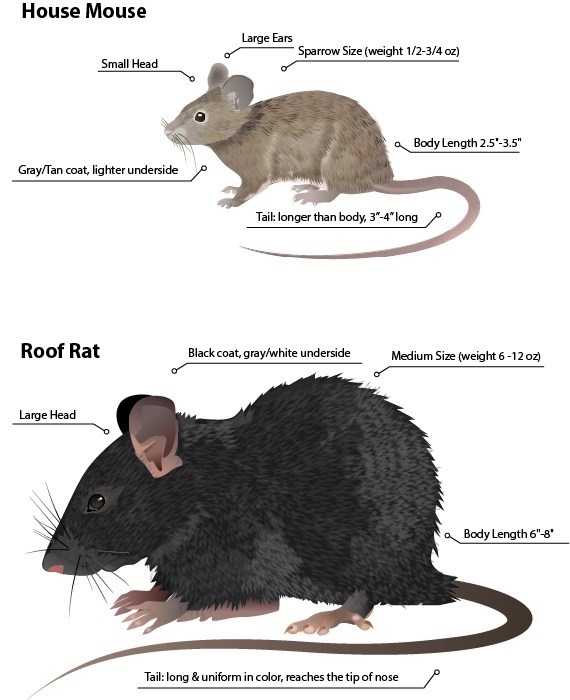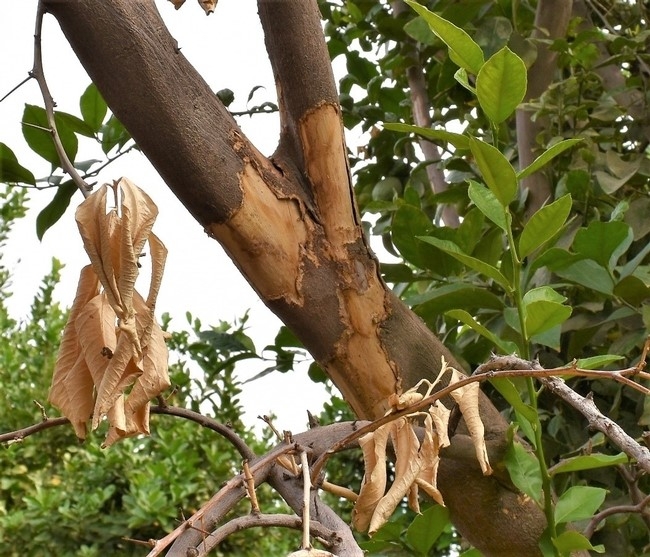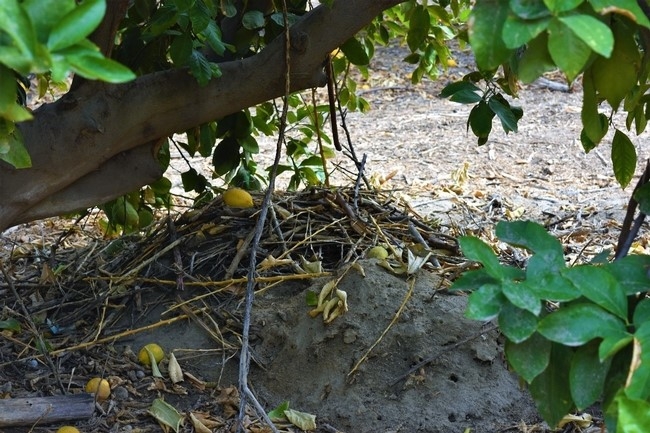- Author: Sonia Rios
The roof rat (Rattus rattus, also known as a citrus rat, fruit rat, black rat, or gray rat) is an introduced species of rat native to southern Asia. It was brought to America on the first ships to reach the New World. This is the same species that carried the bubonic plague around the world and is the reservoir host for murine typhus, which is a disease that is transmitted by fleas. This primarily nocturnal vertebrate is a pest in citrus, nut orchards and other tree crops. In citrus, it builds leaf and twig nests in trees or it can nest in debris piles, thick mulch pile on the ground, or in shallow burrows under the tree. In livestock feed yards and barns, roof rats often burrow and hide under feed bunks or in the hay bales. Adult roof rats range from 12-14 inches long (30-36cm) and weigh 5-10oz. (150-250g) (UC IPM 2017). The large, sleek rat has a pointed muzzle and hairless scale-covered tail that can be longer than the body and head combined.
DAMAGE
A rats gnawing can cause some serious damage to just about anything, electrical wires, wooden structures, and they tend to not be picky about which agriculture crop to invade. Roof rats often feed on citrus, avocados, and other fruits, sometimes leaving hollow fruit skins hanging on the tree. In tree crops, they can girdle limbs or stems, leading to mortality to part or all of a tree. After harvest, they damage fruit and nuts in bins by chewing them and leaving excrement. This can cause major esthetics damage to fruit and become a food safety issue. Since rats are active throughout the year, and mostly at night, this can be a challenge to growers and can become infestation because of their quick gestational period of 3 to 4 weeks.
MANAGEMENT
Cultural Control
Because roof rats are such good climbers, swimmers, and hitchhikers it is hard to completely exclude them from your grove or orchard. Fruit trees should be isolated, not touching fences, overhead wires, or the scaffolds or branches of other trees. Roof rats will run along fence stringer boards or support poles, phone and cable TV wires, and tree branches to reach your fruit tree. Lower branches of the tree should never touch the ground. Reducing shelter and nesting opportunity sites of rats is crucial. Eliminate debris and woodpiles and store materials neatly off the ground. Thin and separate non-crop vegetation around orchards, such as weeds and remove dead wood from fruit trees, especially in citrus and avocado (UC IPM 2017). A low-hanging skirt of drooping branches give the rats additional access routes and provides them with protective cover while feeding. It's best to prune tree skirts so that the ground under them is open and visible. This lack of cover makes the rats uncomfortable and more susceptible to predators such as snakes and birds of prey.
Sanitation is also an important component to an IPM program. Use or remove all fallen fruit, do not leave any fruit behind, as the roof rat is an opportunist and will take advantage of the mess left behind.
Monitoring and Treatment Decisions
According to the UC IPM guidelines, the use of elevated bait stations containing 0.005% diphacinone*-treated oats (sold at some county agricultural commissioner's offices) is highly effective at controlling roof rats in orchards. Secure bait in a bait station before placing in trees on limbs 6 feet or more above the ground. Placing the bait in a secure bait station will prevent bait from dropping to the ground and creating a hazard for non-target species. Bait can only be applied during the non-bearing season, so growers must take a proactive approach to managing problematic rat populations (UC IPM 2017).
Trapping
Rat-sized snap or wooden box traps placed in trees are also effective, although a more time-consuming control option. Do not use glue board traps outdoors, as birds, lizards, and other non-target wildlife may be trapped. Rats are wary, tending to avoid baits and traps for at least a few days after their initial placement. Fasten traps to limbs and bait them with fruit or nut meats, but do not set the traps until after bait is readily eaten. Be aware that certain types of rat baits for use inside buildings (such as sticky traps) are not labeled for use outdoors in orchards; these are hazardous to wildlife and should not be used.
Preventative care, sanitation and scouting for rat's nests or damage is the easiest way to stop a problem before it becomes a problem. For more information regarding the roof rat, please visit the UC IPM website: http://ipm.ucanr.edu/PMG/PESTNOTES/pn74106.html.
Baiting *Be sure to identify the species of rat present to avoid killing non-target or protected species.*






